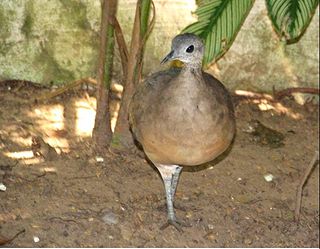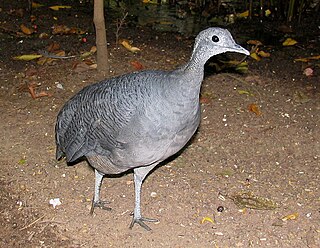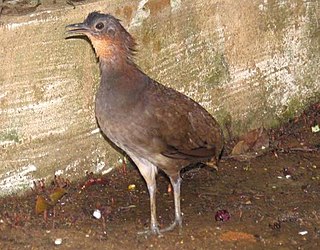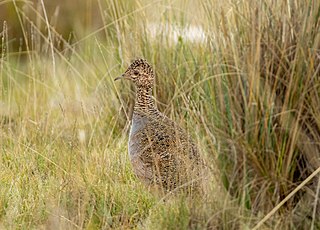
The red-winged tinamou is a medium-sized ground-living bird from central and eastern South America. Other common names for the species include perdiz grande, rufous tinamou, and ynambu.

The white-throated tinamou is a species of bird native to the Amazon rainforest of Brazil, northern Bolivia, southeastern Colombia, northeastern Ecuador, eastern Peru and southern Venezuela.

The brown tinamou is a brownish ground bird found in humid lowland and montane forest in tropical and subtropical South America.

The Andean tinamou is a tinamou, found commonly in high-altitude shrubland, in the Andes of South America.

The puna tinamou also known as Pentland's tinamou, is a member of the most ancient groups of bird families, the tinamous. This species is native to southern South America. The binomial name of the species commemorates the Irish natural scientist Joseph Barclay Pentland (1797–1873) by Nicholas Aylward Vigors in 1837. The IUCN list this species as Least Concern, with an occurrence range of 590,000 km2 (230,000 sq mi).

The grey tinamou is a type of ground bird native to South America. Four subspecies are recognised.

The highland tinamou or Bonaparte's tinamou is a type of ground bird found in montane moist forest typically over 1,500 m (4,900 ft) altitude.

The tawny-breasted tinamou is a type of ground bird found in montane moist forest. Their range is northwestern South America.

The pale-browed tinamou is a type of tinamou found in tropical dry forests in Peru and Ecuador.

The Brazilian tinamou is a type of tinamou found in tropical moist lowland forest in regions of Amazonian South America.

The black-capped tinamou is a type of tinamou commonly found in the moist forest lowlands in subtropical and tropical regions.

The thicket tinamou or rufescent tinamou is a type of tinamou commonly found in moist forests in subtropical and tropical central Mexico.

The rusty tinamou or short-billed tinamou is a type of tinamou commonly found in swamp forest in tropical regions of South America.

The small-billed tinamou is a type of Tinamou commonly found in dry savanna in Amazonian South America.

The Tataupa tinamou is a type of tinamou commonly found in dry forest in subtropical and tropical regions in southeastern South America.

Taczanowski's tinamou is a type of ground bird found in the eastern Andes in Peru in the Junín, Cuzco, Apurímac, Ayacucho, and Puno Regions.

The ornate tinamou is a type of tinamou commonly found in the high altitude grassland and dry shrubland in subtropical and tropical regions of west central South America.

The curve-billed tinamou is a type of tinamou commonly found in high-altitude grassland and shrubland habitats in the Andes of South America.

The huayco tinamou, also known as waypu (Quechua), is a species of bird found on grassy mountain ridges in the Andes of Bolivia and Argentina.

Nothocercus is a genus of birds in the tinamou family. This genus comprises three species of this South American family.






















